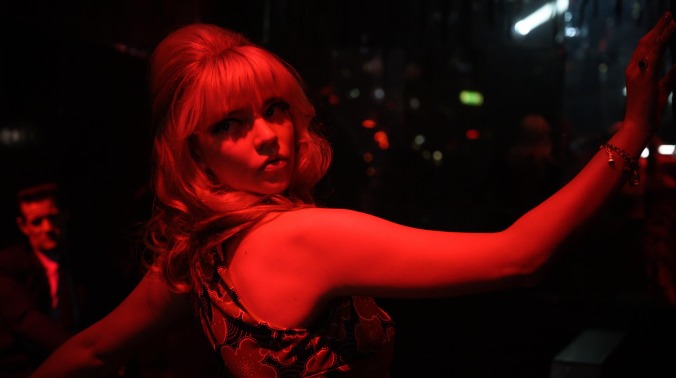Edgar Wright tries his hand at throwback thrills in the flawed, stylish Last Night In Soho
Thomasin McKenzie and Anya Taylor-Joy star in the writer-director’s stab at straightforward horror


After dancing around the genre for decades, Edgar Wright has finally attempted a straightforward horror-thriller. Yet even as he moves away from parodies like his 2004 breakout hit Shaun Of the Dead, the British writer-director retains an affinity for pastiche. Set alternately in present-day Soho and in the semi-mythical “swinging London” of the 1960s, Wright’s new movie, Last Night In Soho, draws inspiration from cinematic styles popular half a century ago.
Chief among these is the “woman losing her grip on reality” trope popularized by Roman Polanski’s 1965 film Repulsion. But Wright also incorporates elements of the sexy Italian murder mysteries known as giallo. (He’s certainly got the Dario Argento-style colored lighting down.) It can be truly excruciating to litigate the boundaries of genre. So let’s just say that Last Night In Soho is giallo in at least one big respect: Like many of those films, it starts off with a strong concept, then crumbles when it’s time to move beyond striking imagery and get down to the more functional aspects of storytelling.
Soho, which Wright cowrote with Krysty Wilson-Cairns (1917), is also the writer-director’s first film with a female lead. One might say it actually has two leads, but the audience’s point of identification is Eloise (Thomasin McKenzie), a timid country mouse from Cornwall who’s obsessed with the ’60s and dreams of becoming a fashion designer. It’s not clear if Eloise has the gift of second sight or is simply burdened by her family history, but it’s established early on that she sees visions of her mother, who died by suicide when Eloise was just a little girl. That’s one reason why her grandmother (Rita Tushingham) worries about her as she runs off to London in pursuit of her heart’s desire. Another is that “the city isn’t safe for a young girl,” particularly a naive one.
Eloise gets a lesson in this early on, in the form of a lecherous cab driver who’s a little too interested in the exact location of her dormitory. Fitting in at design school is a struggle as well, given that her roommate, Jocasta (Synnøve Karlsen), is a pushy mean girl. Jocasta’s cutting remarks and callous disregard prompt Eloise to use the last of her scant resources to find some off-campus housing—namely, a bedsit lent out by the motherly Ms. Collins (Diana Rigg, in her final screen role), who hasn’t updated the attic room in her creaky old house in decades. Which, of course, is just the way Eloise likes it.
Soon after, our young heroine begins having vivid, intoxicating dreams that transport her back to 1966. Part time travel, part haunting, Eloise’s nightly visions connect her to a previous resident of her room, Sandie (Anya Taylor-Joy), a glamorous aspiring singer who has all the confidence and charm Eloise lacks. At first, Eloise can’t wait to fall asleep, savoring the opportunity to strut through lavish nightclubs in the fashions she’s been daydreaming about all her life. Enhanced by some inventive camerawork from Wright—between this film and Candyman, it’s been a good year for clever mirror shots—the sequences are pure wish fulfillment, for character and audience alike.
This portion of the film unfolds a bit like the recent Disney live-action origin story Cruella, in the sense that it uses London in the ’60s as a playground for modern viewers longing for a more “authentic” aesthetic era. Wright has better and more focused taste, however, dropping in twee jangle-pop and kitschy top-40 belters—Petula Clark’s “Downtown” plays a major role in the story—to enhance the mood or create ironic contrast where necessary. Veteran costume designer Odile Dicks-Mireaux also does eye-popping work, outfitting Sandie in groovy crochet, billowing chiffon, go-go boots, and a white vinyl trench coat Eloise eventually dons in the present.
Soon enough, however, Sandie’s suave “manager,” Jack (Matt Smith), begins to show his true, violent face, and Sandie/Eloise’s dream life turns into a sordid, violent nightmare. As Sandie’s dilemma deepens, Wright incorporates some chilling horror elements, like transparent male figures whose faces are constantly shifting, a visual manifestation of the film’s rather heavy-handed theme of the ubiquity of sexual violence. These hulking phantoms, murmuring “that’s such a pretty name” as they hover over Eloise’s sleeping body, could be anybody. And by the film’s logic, they’re essentially everybody: an omnipresent, ambient male threat. It’s possible here to admire Wright’s good intentions and still wonder if there’s something a little superficial about his depiction of the danger women in his audience acutely understand.
And for all the attention Wright pays to costumes and sets, he can be oblivious about the implications of his imagery. Certainly, neither he nor Wilson-Cairns seem to have considered them in regards to a harrowing aborted sex scene where Eloise conflates the predatory ghosts of the past with the man she’s brought home in the present, classmate and love interest John (Michael Ajao). The sequence is masterfully edited and staged to maximize audience discomfort, which only enhances the careless optics of putting a Black actor in this scenario—especially given how Last Night In Soho generally uses Ajao’s character and then puts him aside until he’s needed again.
It’s not the only fumble: A desperate third-act narrative twist doesn’t totally undermine the film’s feminist agenda, but it does leave a bitter aftertaste. The larger problem here lies in the shallow characterizations. Perhaps if there was more to Sandie than victimhood and fabulous dresses, and more complexity to Eloise’s motivations, these stumbling blocks would be more easily cleared. But as in Wright’s last film, Baby Driver, the characters are shiny objects first and people second—a choice that assures that Last Night In Soho’s merits are almost entirely on a surface level. For Wright, dialing back the jokes shouldn’t have to mean dialing back the humanity as well.